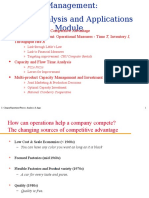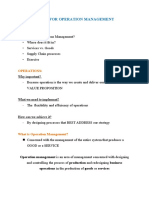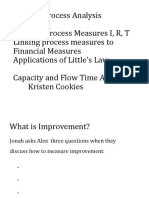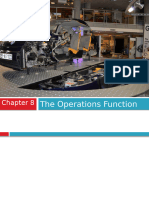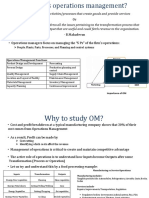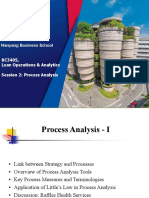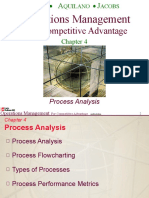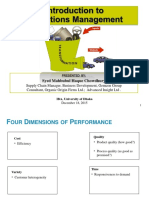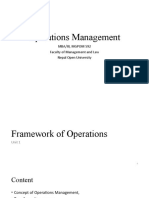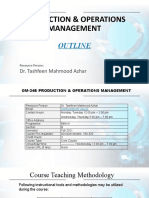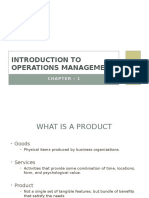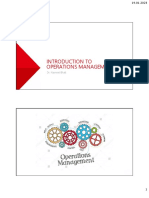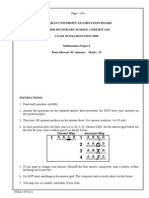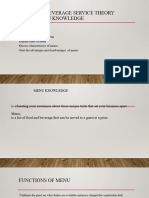Operations Management:
Process Analysis and Applications Module
Changing Sources of Competitive Advantage Targeting Improvement: Operational Measures - Time T, Inventory I, Throughput rate R
Link through Littles Law Link to Financial Measures Targeting improvement: CRU Computer Rentals
Capacity and Flow Time Analysis
Pizza Pazza Levers for Improvement
Multi-product Capacity Management and Investment
Joint Marketing & Production Decisions Optimal Capacity Investment National Cranberry Cooperative
S. Chopra/Operations/Process Analysis & Apps
�How can operations help a company compete? The changing sources of competitive advantage
Low Cost & Scale Economies (< 1960s) You can have any color you want as long as it is black Focused Factories (mid 1960s) Flexible Factories and Product variety (1970s) A car for every taste and purse.
Quality (1980s) Quality is free. Time (late 1980s-1990s) We love your product but where is it? Dont sell what you produce. produce what sells.
2
S. Chopra/Operations/Process Analysis & Apps
�What is Improvement? Operational Performance Measures
Flow time Throughput Inventory Process Cost Quality
S. Chopra/Operations/Process Analysis & Apps
�The business imperative: creating economic value
Improvement levers Revenues Price x Quantity Material + Labor + Energy + Overhead 1. 2. Increase price Increase throughput
Profit
Costs Economic value added (EVA) -
3. 4.
Reduce costs Improve quality
Capital invested Opportunity cost x Weighted average cost of capital
PP&E + Inventory + Other
5. 6.
Reduce capital intensity Reduce inventory
Reduce time
Operational metrics
4
Financial metrics
S. Chopra/Operations/Process Analysis & Apps
�Relating operational measures (flow time T, throughput R & inventory I) with Littles Law
Inventory I Flow rate/Throughput R
...
... ...
[units]
... ...
[units/hr]
Flow Time T [hrs]
Flow time = Inventory / Throughput T = I/R Turnover = Throughput / Inventory = 1/ T
5
S. Chopra/Operations/Process Analysis & Apps
�Process Flow Examples
Customer Flow: Taco Bell processes on average 1,500 customers per day (15 hours). On average there are 75 customers in the restaurant (waiting to place the order, waiting for the order to arrive, eating etc.). How long does an average customer spend at Taco Bell and what is the average customer turnover? Job Flow: The Travelers Insurance Company processes 10,000 claims per year. The average processing time is 3 weeks. Assuming 50 weeks in a year, what is the average number of claims in process.
Material Flow: Wendys processes an average of 5,000 lb. of hamburgers per week. The typical inventory of raw meat is 2,500 lb. What is the average hamburgers cycle time and Wendys turnover?
S. Chopra/Operations/Process Analysis & Apps
�Process Flow Examples
Cash Flow: Motorola sells $300 million worth of cellular equipment per year. The average accounts receivable in the cellular group is $45 million. What is the average billing to collection process cycle time? Question: A general manager at Baxter states that her inventory turns three times a year. She also states that everything that Baxter buys gets processed and leaves the docks within six weeks. Are these statements consistent?
S. Chopra/Operations/Process Analysis & Apps
�Targeting Improvement MBPF Inc.: Consolidated Statement
Net Sales Costs and expenses Cost of Goods Sold Selling, general and administrative expenses Interest expense Depreciation Other (income) expenses TOTAL COSTS AND EXPENSES INCOME BEFORE INCOME TAXES PROVISION FOR INCOME TAXES NET INCOME RETAINED EARNINGS, BEGINNING OF YEAR LESS CASH DIVIDENDS DECLARED RETAINED EARNINGS AT END OF YEAR NET INCOME PER COMMON SHARE DIVIDEND PER COMMON SHARE
S. Chopra/Operations/Process Analysis & Apps
250.0
175.8 47.2 4.0 5.6 2.1 234.7 15.3 7.0 8.3 31.0 2.1 37.2 0.83 0.21
8
�Targeting Improvement MBPF Inc.: Balance Sheet
CURRENT ASSETS Cash Short-term investments at cost (approximate mkt.) Receivables, less allowances of $0.7 mil Inventories Other current assets TOTAL CURRENT ASSETS PROPERTY, PLANT AND EQUIPMENT (at cost) Land Buildings Machinery and equipment Construction in progress Subtotal Less accumulated depreciation NET PROPERTY, PLANT AND EQUIPMENT Investments Prepaid expenses and other deferred charges Other assets TOTAL ASSETS 2.1 3.0 27.9 50.6 4.1 87.7
2.1 15.3 50.1 6.7 74.2 25.0 49.2 4.1 1.9 4.0 146.9
S. Chopra/Operations/Process Analysis & Apps
�Targeting Improvement MBPF Inc.: Inventory and Cost of Goods
INVENTORY Raw materials (roof) Fabrication WIP (roof) Purchased parts (base) Assembly WIP Finished goods TOTAL COST OF GOODS SOLD Raw materials Fabrication (L&OH) Purchased parts Assembly(L&OH) TOTAL 6.5 15.1 8.6 10.6 9.8 50.6
50.1 60.2 40.2 25.3 175.8
S. Chopra/Operations/Process Analysis & Apps
10
�Targeting Improvement
MBPF Business Process Flows
$60.2/yr $25.3/yr
$50.1/yr
$6.5
Raw Materials (roofs)
$15.1
Fabrication (roofs)
$110.3/yr
$10.6
Assembly
$175.8/yr
$9.8
$175.8/yr
$40.2/yr
$8.6
Purchased Parts (bases)
Finished Goods
$40.2/yr
S. Chopra/Operations/Process Analysis & Apps
11
�Targeting Improvement MBPF Inc.: Flow Times
Raw Materials Throughput R $/Year $/Week Inventory I ($) Flow Time T = I/R (weeks) 50.1 0.96 6.5 6.75
Fabrication
Purchased Parts 40.2 0.77 8.6 11.12
Assembly
Finished Goods 175.8 3.38 9.8 2.90
110.3 2.12 15.1 7.12
175.8 3.38 10.6 3.14
S. Chopra/Operations/Process Analysis & Apps
12
�Targeting Improvement
Flow rate R ($/week)
5.0
3.38
Accounts
Assembly
2.12 0.96 0.77
Fabrication
Receivabl e
Finished Goods
Purchased Parts
11.12
Raw Materials
6.75
7.12
3.14
2.90
5.80
Flow Time T (weeks)
S. Chopra/Operations/Process Analysis & Apps 13
�Why the Difference in Performance?
Inventory Over Last 8 Quarters (Ending Q3 2001)
6000
5000
4000
Inventory
3000
Nokia Ericsson Motorola
2000
1000
0 0 1 2 3 4 5 6 7 8 9
Quarter
S. Chopra/Operations/Process Analysis & Apps 14
�CRU Computer Rentals
S. Chopra/Operations/Process Analysis & Apps
15
�Learning Objectives Basic Process Analysis
Process Measures: time, inventory, and throughput What is an improvement?
Link financial and operational measures Good operational measures are leading indicators of financial performance
Using Littles law for process flow analysis Targeting areas and performance measures for improvement
S. Chopra/Operations/Process Analysis & Apps
16
�Operations Management:
Process Analysis and Applications Module
Changing Sources of Competitive Advantage Operational Measures: Time T, Inventory I, Throughput rate R
Link through Littles Law Link to Financial Measures Targeting Improvement: CRU Computer Rentals
Capacity and Flow Time Analysis
Pizza Pazza Levers for Improvement
Multi-product Capacity Management and Investment
Joint Marketing & Production Decisions Optimal Capacity Investment National Cranberry Cooperative
S. Chopra/Operations/Process Analysis & Apps
17
�Operational Performance Measures
How to measure and decrease flow times? How to measure and increase throughput?
S. Chopra/Operations/Process Analysis & Apps
18
�Pizza Pazza Flow Chart
S. Chopra/Operations/Process Analysis & Apps
19
�Process Architecture is defined and represented by a process flow chart:
Process = network of activities performed by resources 1. Process Boundaries:
input output
2. Flow unit: the unit of analysis 3. Network of Activities & Storage/Buffers
activities with activity times routes: precedence relationships (solid lines)
4. Resources & Allocation 5. Information Structure & flow (dashed lines)
S. Chopra/Operations/Process Analysis & Apps 20
�Operational Measure: Flow Time Driver: Critical Activity Times
(Theoretical) Flow Time Critical Activity Flow Time efficiency
S. Chopra/Operations/Process Analysis & Apps
21
�Most time inefficiency comes from waiting:
E.g.: Flow Times in White Collar Processes
Industry Life Insurance Consumer Packaging Commercial Bank Hospital Automobile Manufacture Process New Policy Application New Graphic Design Average Flow Theoretical Flow Flow Time Efficiency Time Time 72 hrs. 18 days 7 min. 2 hrs. 34 min. 3 hrs. 5 hrs 0.16% 0.14% 2.36% 3.75% 5.60%
Consumer Loan 24 hrs. Patient Billing Financial Closing 10 days 11 days
S. Chopra/Operations/Process Analysis & Apps
22
�Levers for Reducing Flow Time
Decrease the work content of critical activities
work smarter work faster do it right the first time change product mix
Move work content from critical to non-critical activities
to non-critical path or to ``outer loop
Reduce waiting time.
23
S. Chopra/Operations/Process Analysis & Apps
�Operational Measure: Capacity Drivers: Resource Loads
(Theoretical) Capacity of a Resource Bottleneck Resource (Theoretical) Capacity of the Process Capacity Utilization of a Resource/Process =
throughput [units/hr] capacity [units/hr]
S. Chopra/Operations/Process Analysis & Apps
24
�A Recipe for Capacity Measurements
Resource Unit Load Resource Capacity (time/job) Unit Capacity # of units Total Process Resource Capacity Utilization*
* assuming system is processing at full capacity
S. Chopra/Operations/Process Analysis & Apps
25
�Pricing and Capacity Investment: Pans + Rent another oven at 10/hr?
Resource cost = 8/hour Material cost = 1.4/pizza
Minimum
sale price =
Contribution margin if sale price is 5 / pizza =
S. Chopra/Operations/Process Analysis & Apps
26
�Cost Capacity Profile
Demand Capacity
[units/time]
Process Capacity
Resource x
NCX-10
Furnaces
Marginal Investment Cost
[$/unit/time]
S. Chopra/Operations/Process Analysis & Apps
27
�Levers for Increasing Process Capacity
Decrease the work content of bottleneck activities
work smarter work faster do it right the first time change product mix
Move work content from bottlenecks to non-bottlenecks
to non-critical resource or to third party
Increase Net Availability
work longer increase scale (invest) increase size of load batches eliminate availability waste: decrease changeover time
28
S. Chopra/Operations/Process Analysis & Apps
�Increasing Process Capacity in The Goal
is
to increase the capacity of only the bottlenecks
increase availability of bottleneck resources eliminate non-value added work from bottlenecks
ensure the bottlenecks time is not wasted
reduce/eliminate setups and changeovers reduce starvation & blockage
synchronize flows to & from bottleneck
the load of the bottlenecks (give it to non-bottlenecks)
move work from bottlenecks to non-bottlenecks need resource flexibility
unit capacity and/or
invest
#of units.
29
S. Chopra/Operations/Process Analysis & Apps
�Other factors affecting Process Capacity
Batch (Order) Sizes Product Mix other managerial policies ...
S. Chopra/Operations/Process Analysis & Apps
30
�Product Mix Decisions: Pizza Pazza offers 2 products
Sale Price of thin crust pizza: Cost of Materials: Sale Price of deep dish pizza: Cost of Materials: 5.00/pizza 1.40/pizza 7.50/pizza 1.90/pizza
S. Chopra/Operations/Process Analysis & Apps
31
�Product Mix Decisions
Processing Times Thin Crust Prepare sauce 2 mins. Prepare dough 3 mins Prepare pizza 1 min Load Oven & Set 1 Bake Pack Receive Total
15
25
Deep Dish
29
42
Resource
Jean
Jean
Jean
Jacq+ Oven
Oven
Jacq
Jacq
S. Chopra/Operations/Process Analysis & Apps
32
�Product Mix Decisions
Margin per thin crust pizza = 3.60 Margin per deep dish pizza = 5.60 Margin per oven minute from thin crust = 3.602 / 16 = 0.450 Margin per oven minute from deep dish = 5.602 / 30 = 0.373
S. Chopra/Operations/Process Analysis & Apps
33
�National Cranberry Cooperative
S. Chopra/Operations/Process Analysis & Apps
34
�Learning Objectives: Multi-Product Process Analysis & Apps
Process measures:
Flow time manage critical activities Capacity manage bottleneck resources
Levers for improving
Flow time manage critical activities
Decrease time in critical activities Perform activities in parallel Decrease waiting time
Capacity & Throughput manage bottleneck resources
Decrease unit load of bottleneck resource Move work from bottleneck to non-bottleneck resource Increase availability of bottleneck resource
Shifting bottleneck
Bottleneck affected by product mix, batch size and other factors Product profitability based on $ per unit time on bottleneck
S. Chopra/Operations/Process Analysis & Apps 35
